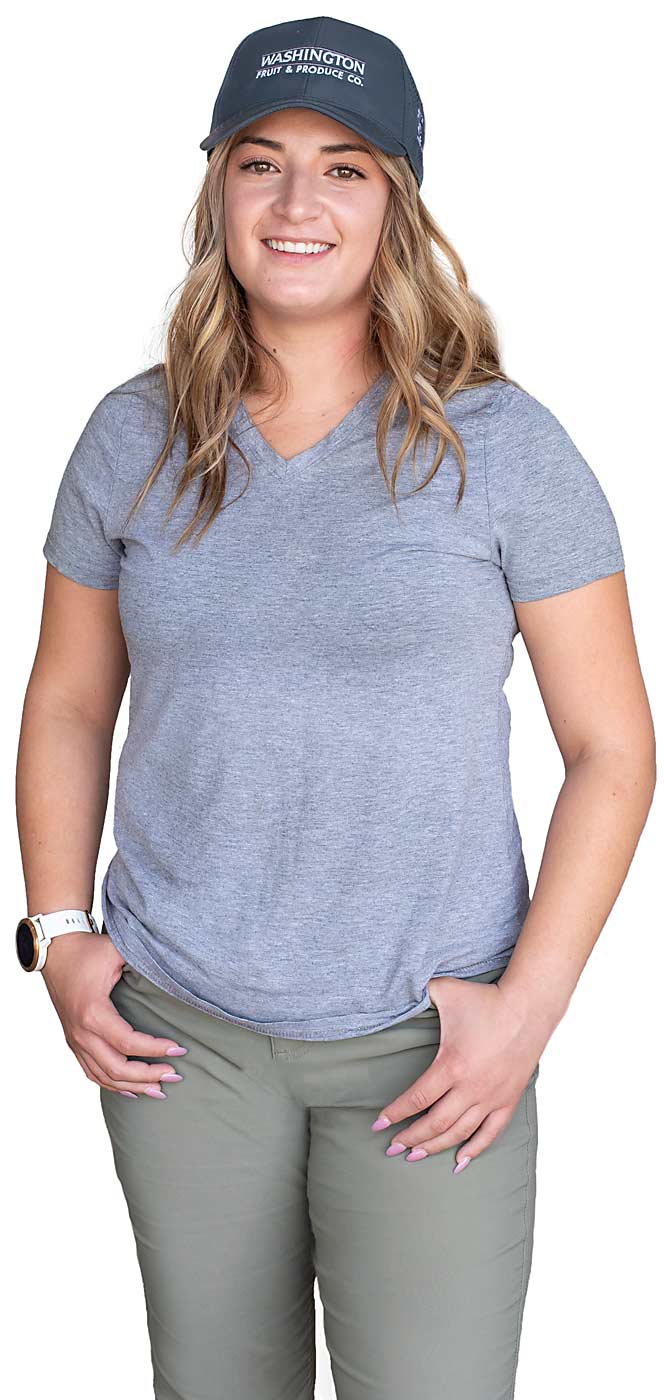family background/Aylin is a first-generation farmer who graduated with a bachelor’s degree from Washington State University, with majors in both fruit and vegetable management and viticulture and enology, with a focus on biochemistry, and a master’s degree in data analytics from University of Washington. She is the daughter of Sandra Espinoza and Hugo Moreno.
age/26
grower/Tri-Cities, Washington
crops/Apples
business/Washington Fruit and Produce Co.
How did you get your start?
Even though my parents were not growers, I’ve always been interested in science. In high school, I wasn’t sure if I wanted to go into physics or biological sciences. When I decided to go to WSU, I pursued plant sciences and yet, I didn’t know what I would gravitate toward. I just wanted to be involved in the sciences because you can solve problems, and it’s something I’m good at.
Through the help of one of my professors, I was directed to look at working in the tree fruit industry because of the opportunities in the postharvest and preharvest sectors. I ended up pursuing fruit and vegetable management and biochemistry to provide myself with career flexibility.
What did you do to learn about the industry?
While in school, I took internship opportunities. My first was as a pest trapper and scout. I learned about the trust a company would give you to take care of a rig, an ATV, and have expectations for you — and it was up to you to meet them.
That lesson really impacted me. I also interned at a fruit company on the growing side of the industry, where I was an assistant orchard manager. Just like any other worker, I was given a set of loppers to learn orcharding from the ground up. I thought those first tasks were a creative and humbling way to teach someone technical skills.
Just because you have a degree doesn’t mean you leave school knowing how to be as technical in the orchard as you need to be. Since I didn’t grow up on a farm, I wanted to get the hang of every task.
What did you do after school?
When I graduated from college, my first job was a newly created position at a fruit company. It gave me an opportunity to prove myself. I went into it not knowing where my career path was going to lead, working through a steep learning curve and many tough lessons.
Looking back at school, every experiment you’re working on has relatively perfect circumstances. When you’re out in a working orchard for the first time, reality hits that nothing is perfect. It’ll never be perfect. However, you need to do good work and execute plans well.
On top of that, you learn that it’s a business and you need to pay off your investments. Those early experiences led me to pursue my MBA in data analytics.
I wanted to be more knowledgeable in finance and economics. I wanted to collect data from the field to improve the orchard — by understanding trends — and solve problems.
What challenges have you faced?
After my MBA, I had been working in logistics and I decided to pursue an opportunity in research and development. I challenged myself. As a young grower, I find it difficult to communicate well with people with a lot of experience.
Even though I don’t sound like I get intimidated, I do. What helps me is believing that if I come from a place of passion and wanting to help solve problems, I’ll find the strength to learn more, obtain experience and succeed.
No one is going to solve your problems except yourself — you must take that initiative and put yourself out there to forge a career.
What challenges do you see in your job?
Information overload is happening every day, for everyone. Even if we do have the information, it seems it’s either too much to work with or not enough. So, how do you sift through a mountain of information when you need the solution now?
Before diving in, I look for what we’re trying to achieve. If someone were to come to me asking for advice with their data projects, I would ask, “What three things are you trying to get from it?” Once you know that, you can formulate a plan, then pick out the factors or the variables that are crucial in understanding what you’re trying to achieve.
Problem-solving isn’t just looking at one set of factors, like sensor data, financial data or weather data. Merging all your varying data sets can help you tell a more complete story when looking for solutions.
How do you approach data collection?
Farm solutions come when you can say, “I know I have steady data sets coming from that particular orchard because of A, B, C in the field.” You’ll be able to use that information and use statistics to find trends, which leads to looking for more info.
If you can create three or four reliable data sources that correlate to each other, and run statistical analysis on it, then you’ll be able to figure out if an orchard practice is beneficial or not. Did it pay off or not? Was it all just a waste of time? Some people have told me that doing R&D work is hard because you don’t see anything in return.
What they don’t realize is that showing something doesn’t work, not by just looking at the plant, but by looking at the data sets, is valuable. I absolutely love numbers because you can quantify something and find a path forward.
—TJ Mullinax







Leave A Comment